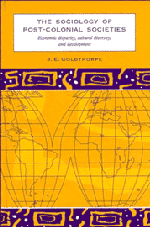Book contents
- Frontmatter
- Contents
- Preface and acknowledgements
- 1 Introduction and argument
- 2 Technology, society, and population
- 3 The colonial episode and the race question
- 4 Economic conditions
- 5 Environmental concerns
- 6 The social sciences and the ‘Third World’
- 7 The rise of towns
- 8 Family life in a changing world: two studies
- 9 Cultural diversity, language, education, and communications
- 10 Religion and development
- 11 Individual modernization: some psychological studies
- 12 Politics in post-colonial states
- 13 Aid and development
- Notes
- Index
8 - Family life in a changing world: two studies
Published online by Cambridge University Press: 03 May 2011
- Frontmatter
- Contents
- Preface and acknowledgements
- 1 Introduction and argument
- 2 Technology, society, and population
- 3 The colonial episode and the race question
- 4 Economic conditions
- 5 Environmental concerns
- 6 The social sciences and the ‘Third World’
- 7 The rise of towns
- 8 Family life in a changing world: two studies
- 9 Cultural diversity, language, education, and communications
- 10 Religion and development
- 11 Individual modernization: some psychological studies
- 12 Politics in post-colonial states
- 13 Aid and development
- Notes
- Index
Summary
W. J. Goode: ‘fit’ and ‘convergence’
In his wide-ranging study World Revolution and Family Patterns, the American sociologist W. J. Goode advanced two main theses. First, that there was a ‘fit’ or congruence between the conjugal family and the modern industrial economy. Goode used the term conjugal as a shorthand expression for the whole complex of characteristics of the western family: an emphasis on the nuclear family household as the normal residential unit, bringing up children and managing its own affairs in relative financial independence; monogamy, relatively free choice of marriage partner, egalitarianism in relations between spouses, some provision for divorce in case of marital breakdown, though with checks and safeguards for the interest of dependent children; bilateral descent, an absence of clan or lineage structures and of joint family systems giving other kin (the ‘elders’ as he called them) the right to interfere in the choice of marriage partner or the management of the nuclear family household.
Western family life had ‘always’ approximated to the conjugal model, certainly for many centuries before the industrial revolution. It was not a response to industrialization, the result of a breakdown of an earlier extended family system. ‘The classical family of western nostalgia’ was a myth. A form of the family emphasizing the husband–wife–child unit might very well have been ‘a facilitating factor for industrialization, rather than the other way round’.
According to Goode, the conjugal family system facilitated both geographical mobility and ‘class-differential’ mobility.
- Type
- Chapter
- Information
- The Sociology of Post-Colonial SocietiesEconomic Disparity, Cultural Diversity and Development, pp. 142 - 148Publisher: Cambridge University PressPrint publication year: 1996



